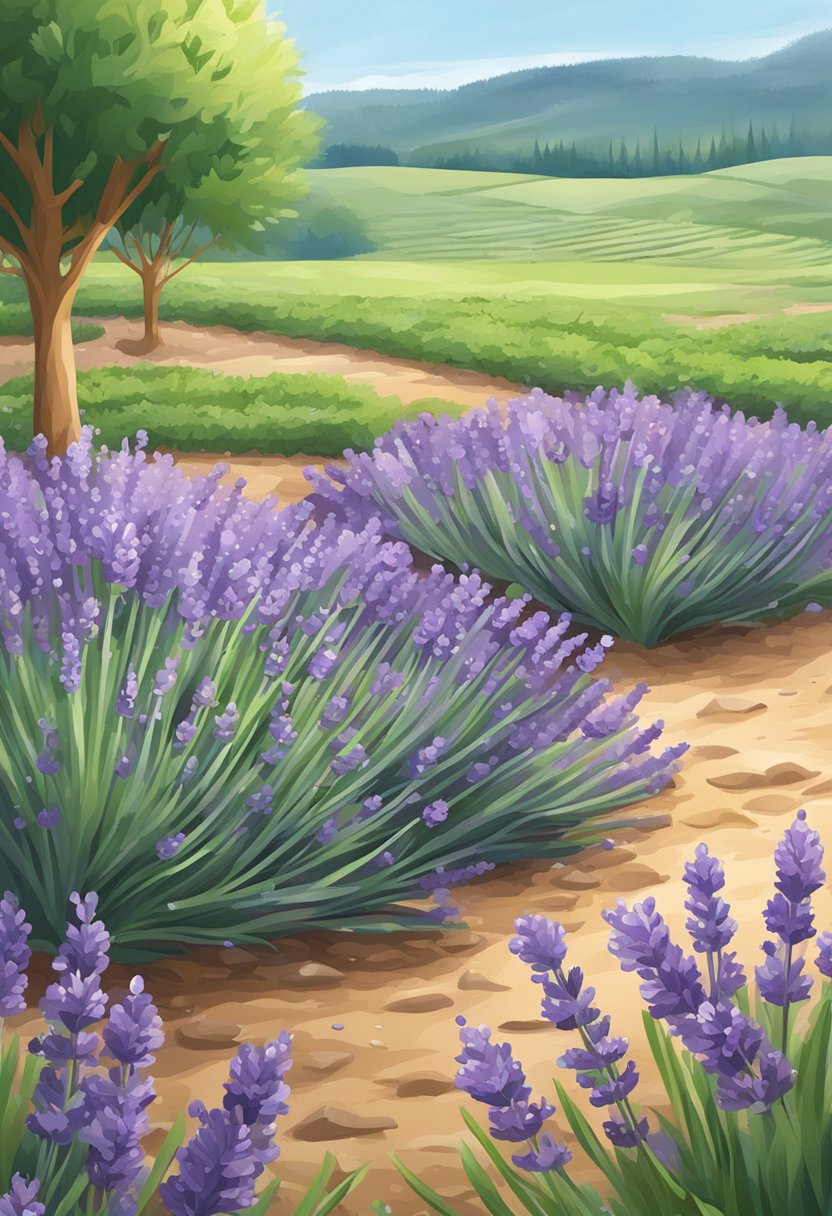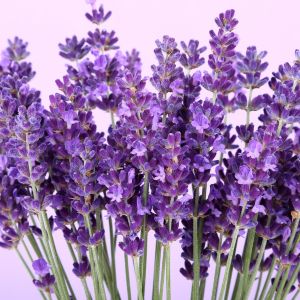When it comes to growing lavender plants, one of the most important factors to consider is watering. Lavender is a drought-tolerant plant, but it still needs water to thrive. The amount of water lavender needs depends on various factors, including the climate, soil type, and stage of growth.
This post may contain affiliate links.
If you’re wondering how much water lavender needs, the answer is that it varies depending on the circumstances. Generally, lavender plants need about an inch of water per week, but this can vary depending on the climate.
In hot, dry climates, lavender may need more water to stay healthy, while in cooler, wetter climates, it may need less.
It’s important to monitor the soil moisture level and adjust your watering accordingly. Overwatering can be just as harmful as underwatering, so be sure to find the right balance.
Related Article: Deadheading Lavender: A Guide to Promoting Blooms
When caring for your lavender plants, it’s important to water deeply and infrequently rather than giving them frequent shallow watering. This encourages deep root growth and helps the plant become more resistant to drought.
Related Article: Growing Lavender in Pots: Tips and Tricks for a Beautiful Garden
In addition, it’s best to water in the morning so that the foliage has time to dry before nightfall, which can help prevent fungal diseases. With the right care and attention, your lavender plants can thrive and provide you with beautiful blooms and a lovely fragrance.
Understanding Lavender’s Water Needs
Lavender is a popular plant known for its aromatic fragrance and beautiful purple flowers. But, how much water does lavender need?
Proper watering is crucial to keep your lavender healthy and thriving. In this section, we will discuss the watering schedule for lavender and signs of overwatering and underwatering.
Related Article: Are Lilacs Edible? Discover the Answer Here
Watering Schedule
Lavender is a drought-tolerant plant that prefers well-drained soil. Overwatering can lead to root rot, which can be fatal to your lavender plant.
On the other hand, underwatering can cause wilting, yellowing or browning leaves, and drooping leaves and stems. To avoid these issues, it is important to water your lavender plant properly.
During the growing season, which is typically from spring to fall, you should water your lavender plant deeply once a week.
This will help the roots to grow deep into the soil and establish a strong foundation. However, if you live in a hot and dry climate, you may need to water your lavender plant more frequently.
In the winter months, when the plant is dormant, you should reduce watering to once every two to three weeks. This will prevent the roots from rotting due to excess moisture.
Signs of Overwatering and Underwatering
Overwatering can cause the roots to rot, which can lead to wilting, yellowing or browning leaves, and drooping leaves and stems.
The leaves may also become soft and mushy to the touch. If you notice any of these signs, you should reduce the watering frequency and let the soil dry out before watering again.
Underwatering can cause the leaves and stems to droop and wilt. The leaves may also become dry and brittle to the touch. If you notice any of these signs, you should increase the watering frequency and water your lavender deeply.

Soil Requirements for Optimal Growth
To ensure that your lavender plants grow successfully, it is important to pay attention to the soil they are planted in. Here are some key factors to consider when it comes to soil requirements for optimal growth.
Soil Texture and Drainage
Lavender plants require well-draining soil to thrive. This means that the soil should not be too heavy or compacted, as this can lead to poor drainage and waterlogged roots. Instead, aim for a lean soil mixture that is light and airy, with good drainage properties.
One way to test the drainage properties of your soil is to dig a hole and fill it with water. If the water drains away quickly, the soil has good drainage. If the water remains in the hole for an extended period of time, the soil may be too heavy or compacted.
Amending Soil for Lavender
If your soil is not ideal for lavender plants, you can amend it to improve its texture and drainage properties. One way to do this is by adding sand to the soil mixture. Sand helps to improve drainage and can also help to loosen up heavy or compacted soil.
Another way to amend soil is by adding organic matter, such as compost or well-rotted manure. Organic matter helps to improve soil structure and can also provide essential nutrients for your lavender plants.
When amending soil, it is important to mix the new materials thoroughly with the existing soil to ensure that the texture and drainage properties are consistent throughout. Aim for a soil mixture that is roughly 50% soil, 25% sand, and 25% organic matter.
By paying attention to soil requirements for optimal growth, you can help your lavender plants to thrive and produce beautiful blooms year after year.
Seasonal Watering Variations
When it comes to watering your lavender, the amount of water it needs can vary depending on the season. Here are some tips to help you keep your lavender healthy and thriving throughout the year.
Summer Care
During the summer months, your lavender will need more water than during the winter. This is because the hot sun and dry air can quickly dry out the soil. To keep your lavender hydrated, it is recommended that you water it deeply once a week.
When watering your lavender, make sure to water the soil and not the leaves. Watering the leaves can cause them to burn in the hot sun. Additionally, it is best to water in the morning or evening when the sun is not as strong.
Winter Considerations
In the winter, your lavender will need less water than during the summer. This is because the cooler temperatures and increased humidity can help to keep the soil moist. Overwatering your lavender in the winter can lead to root rot and other issues.
To protect your lavender during the winter, it is recommended that you provide it with some winter protection. This can include covering the plant with a layer of mulch or straw to help insulate the roots and protect them from the cold.
By following these seasonal watering variations, you can help to ensure that your lavender stays healthy and vibrant all year round. Remember to always keep an eye on the soil moisture and adjust your watering schedule as needed.
Lavender Plant Maintenance
Taking care of your lavender plants is an essential part of ensuring they grow healthy and strong. Here are a few tips to help you maintain your lavender plants.
Pruning for Healthier Plants
Pruning your lavender plants is crucial for maintaining their shape and health. Pruning helps promote new growth and prevents the plant from becoming too woody. It’s best to prune your lavender plants in the spring before new growth appears.
To prune your lavender plants, use a sharp pair of pruning shears and cut back the stems by one-third. Be sure to cut just above a set of leaves to encourage new growth. You can also remove any dead or damaged stems.
Fertilization and Nutrients
Lavender plants don’t require a lot of fertilizer, but they do need some nutrients to grow healthy. It’s best to fertilize your lavender plants in the spring and fall with a liquid plant fertilizer.
When fertilizing your lavender plants, be sure to follow the instructions on the fertilizer package. Over-fertilizing can damage the plant and cause it to produce fewer flowers.
In addition to fertilizer, lavender plants also need well-draining soil. If your soil is heavy or clay-like, add some sand or perlite to improve drainage.
By following these tips for pruning, fertilization, and nutrients, you can help your lavender plants thrive and produce beautiful flowers.
Planting and Propagation Tips
Choosing the Right Lavender Variety
When it comes to choosing a lavender variety, it’s important to consider the climate and growing conditions in your area.
English lavender (Lavandula angustifolia) is a popular choice for cooler climates, while French lavender (Lavandula stoechas) and Spanish lavender (Lavandula dentata) are better suited for warmer regions.
If you’re planning to grow lavender indoors, make sure to choose a variety that can thrive in containers and doesn’t require full sun. Munstead and Hidcote are two English lavender varieties that are well-suited for indoor cultivation.
Propagating New Lavender Plants
Propagating new lavender plants is an easy and cost-effective way to expand your garden. The most common method of propagation is through cuttings. To propagate lavender from cuttings, follow these steps:
- Take a cutting from a healthy lavender plant in the spring or early summer. Make sure the cutting is at least 6 inches long and has several sets of leaves.
- Remove the leaves from the bottom half of the cutting, leaving only a few sets of leaves at the top.
- Dip the cut end of the stem in rooting hormone to encourage root growth.
- Plant the cutting in a pot filled with potting mix and water it thoroughly.
- Place the pot in a sunny location and keep the soil moist but not waterlogged.
- Once the cutting has developed roots and new growth, transplant it into a larger pot or into the ground.
It’s important to note that lavender has a taproot, so make sure to use a deep pot to accommodate the plant’s root system. Also, wait until the soil has warmed up before planting lavender outside to avoid root rot.
Lavender can also be propagated from seeds, but this method is less reliable and may result in plants that are different from the parent plant.
As a companion plant, lavender is a great addition to any garden. It can attract pollinators and repel pests, and it makes a beautiful hedge. Popular lavender varieties for hedges include Lavandin and Provence.
Frequently Asked Questions
When is the best time to water potted lavender?
The best time to water potted lavender is in the morning. This allows the plant to absorb the water it needs throughout the day. Avoid watering in the evening or at night, as this can increase the risk of fungal growth.
What’s the watering schedule for lavender during the cooler fall season?
During the cooler fall season, lavender requires less water than in the summer months. Water your lavender plant once a week or when the soil feels dry to the touch.
How frequently should lavender be watered in the hot summer months?
In the hot summer months, lavender should be watered twice a week or when the soil feels dry to the touch. Be sure not to overwater, as this can lead to root rot.
What are the signs that indicate my lavender plant needs water?
The leaves of a lavender plant will start to droop and wilt when it needs water. The soil will also feel dry to the touch. Be sure to water your plant as soon as you notice these signs.
Is it possible to give lavender too much water?
Yes, it is possible to give lavender too much water. Overwatering can lead to root rot and other issues. Be sure to only water your plant when the soil feels dry to the touch.
How often should I water my lavender seeds to ensure proper growth?
Lavender seeds should be watered lightly once a day until they start to sprout. Once the seedlings have emerged, water them every two to three days or when the soil feels dry to the touch. Be sure not to overwater, as this can lead to damping off and other issues.
Follow my lavender board on Pinterest.



